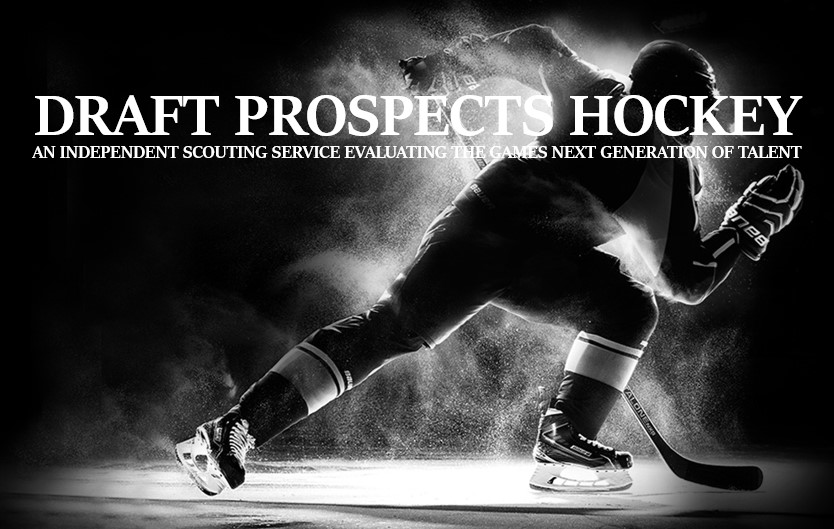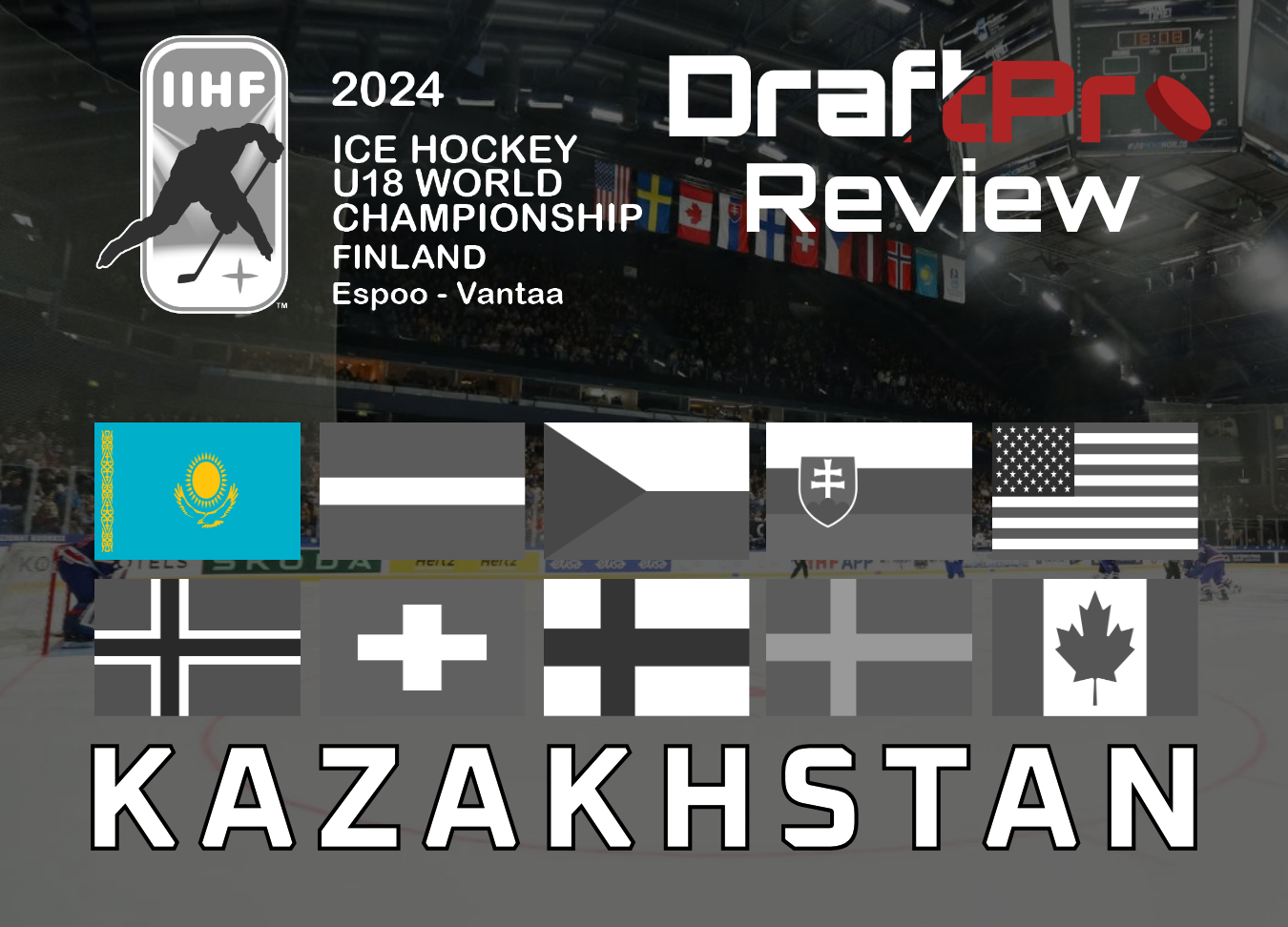By DraftPro Staff
The IIHF World U18 Hockey Championships just wrapped up last week in Espoo and Vantaa Finland, and was a scouting hotspot as a last big event for NHL staffs who are charged with evaluating the next wave of NHL talent.
There were some bright spots for the upcoming 2024 NHL draft that stood out and some future draft eligibles that really grabbed the spotlight. In this ten-part series we will look at each team entry and provide some review of prospects, how they performed and how their performance might have affected their draft stock. We will start with the last place team, Kazakhstan, and work our way through to the gold medal winning Canadian squad.
The Kazakhstan roster often came out of the gates strong, grabbing early leads like 2-0 against Switzerland and 1-0 against Sweden, and starting 1-1 against Canada. Despite these promising starts, victories were tough to come across until Game 3 against the Czechs, where Kazakhstan pulled off one of the tournament’s biggest upsets by securing their first-ever victory at the U18 top event. It was a team effort led by captain Abzal Alibek and defenseman Roman Bolshedvorsky. This high point, however, was bittersweet as Kazakhstan found themselves relegated to Division 1A, setting up a challenge to fight their way back for the 2026 tournament.
Here are some player reports from our Seth Ditchfield on the Kazakhstan U18 players that stood out.

#25 Tanirkhan Alpysbayev G, Barys Astana U18 (Russia U18) 6’1, 165, R, DOB: 2.15.2007
When a small nation gets pummeled in the shot department, it’s not surprising to see a goaltender, known for their confidence and drive, stand on his head at times. However, Tanirkhan Alpysbayev was a different story. With stylistic shades of Jonathan Quick, he produced one highlight reel after another, showing an exceptional level of flexibility and agility that was astonishing, especially for an underager in this tournament. Alpysbayev is a goaltender who effectively combines athleticism, speed, agility, and flexibility. His ability to cover post-to-post with lightning speed underscores his dynamic and somewhat risky playing style, although improved positional play could help reduce the need for such dramatic saves. His rebound control remains a work in progress; he generally manages to swallow the puck and opts for safer plays, whether covering the puck or playing it cautiously. However, his blocker work could be more consistent, often sending pucks flying in unpredictable directions. In the crease, he adopts a tall and aggressive stance, which helps cover the top half of the net, but as a butterfly goalie who frequently drops low, he exposes the top of the net again. On breakaways, his assertive approach effectively shuts down shooting lanes, compelling forwards to attempt dekes, which are usually useless given his strength down low. Although he has some technical challenges and issues with positional consistency, Alpysbayev’s quick recovery and stamina consistently kept his team in the game. If he can refine his technical skills to match his natural talent, he has the potential to excel in the 2025 class and beyond.
#11 Assanali Sarkenov RW, Snezhnye Barys Astana (MHL) 6’4, 187, L, DOB: 7.22.2006
Sarkenov didn’t start the tournament as he would have hoped, looking disinterested in game 1 and earning a suspension in game 2. However, his resurgence against Canada, where he scored three goals against a team that had only let in seven during the entire round-robin, was a dramatic turnaround. This performance showcased Sarkenov’s tenacity and aggressive playing style, a welcome change from his earlier issues. Notably, he’s a natural goal scorer with a quick, heavy release from the high slot that makes him a significant threat whenever he has time and space. Despite occasional moments of frustration and lapses in composure, Sarkenov’s physical attributes—standing at 6’4″ with soft hands, a strong stick, and rapid shot—allow him to excel in puck possession. His skating overall could use improvement, but his solid first step helps him keep pace with, and sometimes overpower, top-level defenders. While his performance in league games might raise questions about his draft potential, Sarkenov’s ability to dominate a game when given a chance indicates that he could be a smart pick in the later rounds. His second-half performance in the tournament revealed a high-upside player who could flourish with the right development.

#10 Abzal Alibek LW, Snezhnye Barys Astana (MHL) 6’0, 163, L, DOB: 3.39.2006
Alibek was a standout player for the Kazakhstan team, combining strong puck skills with notable leadership qualities. Recognized as possibly the strongest skater on his team, Alibek matched the pace of the tournament’s top players, consistently creating opportunities and effectively backchecking and closing lanes. He excelled in transition, adeptly handling passes of any quality and swiftly navigating the neutral zone with confidence. His offensive talent was evident in his snapshot, which secured two early goals against Sweden and Switzerland. Over five games, Alibek tallied five points, missing the scoresheet in only one game, which ironically was arguably his most impressive game—demonstrating his commitment across all three zones and playing a huge role in Kazakhstan’s first-ever win against Czechia in this tournament. Alibek’s work ethic and leadership influenced his team in a big way; he was a constant force on the ice and a seemingly positive presence in the locker room. His engagement off the puck was just as impressive, excelling in puck retrievals and showing keen positional awareness. While moving through defenders, his solid hand skills were apparent. Despite the need to bulk up, improve his balance, and expand his offensive toolkit, Alibek’s foundational strength of character and leadership highlighted his potential every shift. Although his league performance might raise concerns about his draft-ability, any team seeking a hardworking player who can contribute both on and off the ice and develop within their system would find Alibek to be a valuable late-round pick.
#5 Mstislav Shipilin LD, Snezhnye Barys Astana (MHL) 6’0, 174, L, DOB: 3.31.2006
Shipilin, traditionally a stay-at-home defender in the MHL, took on a more mobile and aggressive role during this tournament. He started rough, appearing completely out of place and struggling to keep up with the speedy Swedes. However, he dramatically improved in the second half of the tournament, highlighted by a big game against the Czechs. In that match, he logged 23 minutes and scored the game-winning goal, showcasing a level of mobility and puck skills not previously seen, handling pressure well and creating effectively in the neutral zone. Looking ahead, Shipilin is likely to jump to professional hockey as a mobile defensive defenseman. To succeed, he needs to bulk up, strengthen his play in the slot, and enhance his 4-way skating ability to better handle rush defense.
#4 Roman Bolshedvorsky RD, Snezhnye Barys Astana (MHL) 6’3, 212, L, DOB: 6.18.2006
Bolshedvorsky entered this tournament as an unknown, but he exited the tournament with the attention of scouts on him. Despite not being known as an offensive threat, his first goal of the season against Czechia showed a notable improvement in his puck control and activity, both in the neutral and offensive zones. There were initial doubts about whether his 6’3” frame could translate his potential into the NHL, especially as he often got pushed around and failed to use his size effectively. However, as the tournament progressed, Bolshedvorsky evolved into Kazakhstan’s toughest defender, notably in a standout performance against Czechia where he not only scored 2 points but also logged 21 minutes to help secure the win. While offense may not be his forte, his positional play and physicality lay a solid foundation. Moving forward, maintaining this newfound aggressive edge will be crucial for his development.

#6 Syvatoslav Evplov, LD, Armiya-SKA St.Petersburg U16 (Russia U16) 6’0, 157, L, DOB: 8.27.2008
Evplov stuck out from day one, something the other Kazakhstan defenders could not match. He stood out in the defensively-oriented system with his strong mobility and 4-way skating ability. Evplov effectively controlled the game’s pace from the backend, despite often facing tougher competition. He generally opts for a conservative approach, holding his position and containing forwards over pinching. However, his decision-making in the neutral zone was notably aggressive, demonstrating good timing and spatial awareness. Despite these strengths, Evplov needs to refine his puck retrievals and enhance his passing skills. His strength transition made him a catalyst in starting rushes, although his smaller frame and tendency to rely on reach rather than physical engagement sometimes left him exposed. To continue his development and become a prominent figure for Kazakhstan in 2026, Evplov will need to build up strength to improve his defensive strength against faster and more agile opponents.
************************************************************
It is also almost that time of year where you can get your hands on the comprehensive DraftPro 2024 Draft Guide which will be released in just a few days.
In the 2024 Draft Guide our team ranks the top 224 NHL Draft eligibles, provides well-written profiles on the top 224 names for this year, includes in-depth prospect features, looks at the NHL’s top 50 drafted prospects coming down the pipe, dives into what each NHL team has in the prospect cupboard and what their draft needs are, provides a comprehensive look at the 2025 NHL Draft with profiles on the top 32, provides a top 32 ranking on the 2026 NHL Draft with profiles on the top 10, and so much more.
This year everyone who pre-orders the 2024 Draft Guide digital edition will receive a pre-order discount off the cover price of $12.99 $10.00 each. So don’t wait, get your copy on order for just ten bucks and be the first to receive it as soon as it is published.

